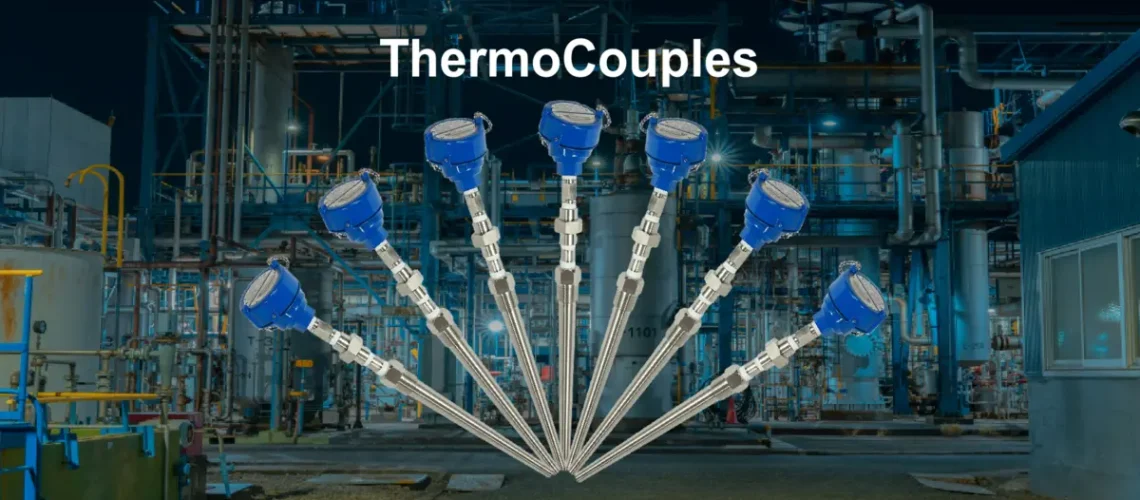Thermocouple sensors are indispensable for process safety, offering a robust, versatile way to monitor temperatures in demanding environments. They deliver reliable data from cryogenic systems to high-temperature furnaces. Whether you choose a Type K for its all-purpose durability or a Type B for extreme heat, understanding their types and configurations ensures you pick the right tool for the job. With proper installation, calibration, and maintenance, thermocouples keep processes safe and efficient. These devices are important in industries like oil and gas, chemical manufacturing and food processing.
What is a Thermocouple Sensor?
A thermocouple sensor is a device that measures temperature by the voltage generated when two different metals are joined and exposed to a temperature difference. This small but mighty tool is a favorite in industries because it’s tough, cost-effective, and can handle extreme conditions, from the icy depths of cryogenic systems to the blazing heat of furnaces. Think of it as a tiny power plant that converts heat into a measurable electrical signal, ensuring processes run safely and efficiently.

How Does a Thermocouple Work?
A thermocouple operates on the Seebeck effect, a phenomenon discovered in 1821 by Thomas Seebeck. When two dissimilar metals, like iron and constantan, are fused at one end (the hot junction or measuring junction) and exposed to a temperature, while the other end (the cold junction or reference junction) is at a known temperature, a small voltage is produced. This voltage, called the electromotive force (EMF), correlates directly to the temperature difference.
Here’s how it works in simple steps:
- Dissimilar Metals: Two different metal wires, such as nickel-chromium and nickel-alumel, are joined to form the hot junction, placed where the temperature is measured.
- Temperature Gradient: The hot junction experiences the process temperature, while the cold junction, often at a stable temperature like 0°C, serves as a reference.
- Voltage Creation: The temperature difference drives electron movement, generating a small voltage (measured in microvolts or millivolts).
- Temperature Conversion: A voltmeter or transmitter measures this voltage and uses standardized calibration tables to translate it into a temperature reading.
To ensure accuracy, cold junction compensation (CJC) adjusts for the cold junction’s actual temperature, often using a secondary sensor like a Pt-100 or electronic compensation. For example, in a refinery monitoring a 1000°C furnace, the thermocouple’s voltage reflects the difference between the furnace and the control room’s ambient temperature, delivering precise data.
The Seebeck effect is backed by other thermoelectric principles, like the Peltier effect (which can cause heating or cooling at junctions) and the Thomson effect (affecting voltage along a single conductor). These laws ensure thermocouples are reliable, even in complex setups.

Types of Thermocouples
Thermocouples come in various types, each defined by its metal combination, tailored to specific temperature ranges and environments. The International Standard Association (ISA) and other standards like IEC 584-1 designate types by letters. Below are the most common types used in process industries, along with their properties and applications:
1. Type K (Chromel-Alumel)
- Materials: Nickel-Chromium (Chromel) and Nickel-Alumel.
- Temperature Range: -200°C to 1350°C.
- Features: Versatile, durable, and resistant to oxidation, Type K is the most widely used thermocouple. It’s sensitive to reducing atmospheres but cost-effective for general use.
- Applications: Chemical plants, refineries, and furnaces.
2. Type J (Iron-Constantan)
- Materials: Iron and Copper-Nickel (Constantan).
- Temperature Range: -40°C to 750°C.
- Features: Affordable but prone to oxidation, especially in humid conditions. Its iron element is magnetic, aiding identification.
- Applications: Older industrial systems and cost-sensitive setups.
3. Type T (Copper-Constantan)
- Materials: Copper and Copper-Nickel (Constantan).
- Temperature Range: -200°C to 350°C.
- Features: Highly accurate at low temperatures and moisture-resistant, making it ideal for cryogenic applications.
- Applications: Food processing, environmental monitoring, and labs.
4. Type E (Chromel-Constantan)
- Materials: Nickel-Chromium (Chromel) and Copper-Nickel (Constantan).
- Temperature Range: -200°C to 900°C.
- Features: High EMF output for better sensitivity, suitable for moderate temperatures but sensitive to sulfur gases.
- Applications: Laboratories and precision monitoring.
5. Type N (Nicrosil-Nisil)
- Materials: Nickel-Chromium-Silicon (Nicrosil) and Nickel-Silicon (Nisil).
- Temperature Range: -270°C to 1300°C.
- Features: Improved stability over Type K, with better resistance to oxidation and corrosion.
- Applications: Power plants and high-temperature processes.
6. Type S, R, and B (Platinum-Rhodium)
- Materials: Platinum and Rhodium alloys.
- Temperature Range:
- Type S: 0°C to 1450°C
- Type R: 0°C to 1450°C
- Type B: 0°C to 1800°C
- Features: Expensive but stable and accurate at high temperatures. Type B is ideal for extreme heat and resistant to contamination.
- Applications: High-temperature furnaces, aerospace, and molten metal processing.

Thermocouple Configurations
Thermocouples are constructed in various forms to suit specific needs:
- Ceramic Bead Insulation: Wires insulated with ceramic beads for simple, fast-response setups, best for labs.
- Casing Thermocouples: Encased in stainless steel or Inconel with insulation like MgO, ideal for harsh industrial environments.
- Film Thermocouples: Thin-foil designs on polymer films for surface measurements, used in electronics or HVAC.
Thermocouples can also have different junction setups:
- Grounded Junction: Fast response but prone to noise.
- Ungrounded Junction: Slower but resistant to electrical interference.
- Dual-Element: Provides redundancy for reliability in critical applications.
Why Thermocouples Matter in Process Safety
Thermocouples are critical for maintaining safety and efficiency in industries like chemical and oil and gas. They monitor temperatures to prevent incidents, such as:
- Chemical Reactors: Ensuring reactions stay within safe limits to avoid runaway conditions.
- Refineries: Tracking distillation column temperatures to optimize separation and prevent overheating.
- Power Plants: Measuring turbine and boiler temperatures for efficiency and safety.
- Food Processing: Maintaining precise temperatures for quality and safety compliance.
Their ability to operate without external power and withstand harsh conditions makes them intrinsically safe for hazardous areas, like those meeting OSHA compliance standards.
Advantages and Challenges
Advantages
- Wide Range: Measure temperatures from -270°C to 1800°C.
- Durability: Withstand high vibration, pressure, and corrosive environments, especially with thermowells.
- Cost-Effective: Affordable compared to RTDs, with no need for external power.
- Fast Response: Bare thermocouples respond quickly, ideal for dynamic processes.
Challenges
- Accuracy: Less precise than RTDs, with errors from ±0.2°C to ±6°C.
- Noise Sensitivity: Low-voltage signals require shielding to avoid electromagnetic interference.
- Calibration Drift: Material degradation can affect accuracy over time, requiring regular calibration.
- Non-Linearity: Voltage-temperature relationships need precise calibration tables.
Practical Tips for Thermocouple Use
To ensure reliable performance:
- Shielding and Grounding: Use twisted pair wires and ground at one point to minimize noise.
- Thermowell Placement: Position against flow direction with adequate immersion (e.g., 10x thermowell diameter) for accurate readings.
- Calibration: Calibrate every 6-12 months in critical applications, using portable calibrators or certified sensors.
- Extension Wires: Use matching thermocouple wires to avoid unintended junctions and errors.
- Maintenance Checks: Monitor resistance to detect wear; high resistance may indicate nearing failure.
People Also Asked Questions with Answers
What is the main principle behind a thermocouple?
The Seebeck effect, where a voltage is generated by a temperature difference between two dissimilar metal junctions, drives thermocouple operation.
How does a thermocouple differ from an RTD?
Thermocouples use voltage from dissimilar metals for a wide temperature range (-270°C to 1800°C) but are less accurate (±0.2°C to ±6°C). RTDs measure resistance changes in metals like platinum, offering higher accuracy (±0.1°C) but limited to 850°C.
Which thermocouple is best for high temperatures?
Type B (Platinum-30% Rhodium / Platinum-6% Rhodium) excels at up to 1800°C, with high stability and chemical resistance, ideal for furnaces and molten metal processing.
Why is cold junction compensation important?
CJC accounts for the reference junction’s temperature, ensuring accurate readings by adjusting for deviations from the standard 0°C.
References:
- Webster, J. G. (Ed.). (1998). The Measurement, Instrumentation and Sensors Handbook. CRC Press.
- Advanced Temperature Measurement and Control, Second Edition, ISA, 2011.
- Michalski, L., Eckersdorf, K., Kucharski, J., & McGhee, J. (2001). Temperature Measurement, Second Edition. John Wiley & Sons.
- Modern Sensors Handbook, Chapter 8: Temperature Sensors.
- McMillan, G., & Considine, D. (1999). Process/Industrial Instruments and Controls Handbook. McGraw Hill.
- https://www.britannica.com
- https://www.sciencedirect.com





